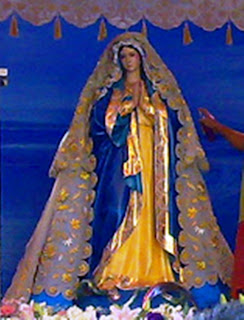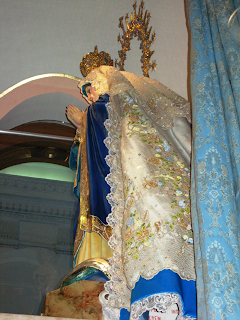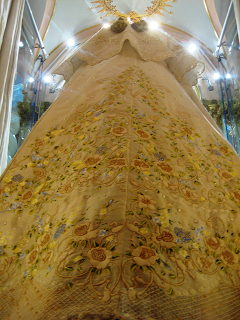Lord, continue to guide and protect our family throughout the year. thank you for Your continuous blessings, tangible and specially those that are intangible.Thank you for supporting us on our personal plans and goals that are according to your will. May we always be reminded that You are always there in all our joys and sorrows.
Our Lady of Pasig, Pray for us!
That in all things, God may be glorified!
Friday, December 31, 2010
Wednesday, December 8, 2010
Viva Inmaculada Concepcion!!!
Solemneng Pagbibihis
just witnessed the 2nd "solemneng pagbibihis" of our lady of Pasig and the Festejada image. a new and more simple manto is what the lady is wearing now.
from afar, it looks like the Lady is wearing an immaculate white manto, but if you look closer, the details shows embroidery of little flowers of different colors.
just like what Fr. Orly said, this manto reflects our love and devotion to our Mother. the great tasks involved in planning, designing and actual needle work of these holy vestments shows how important our Lady is to all Her devotees.
that in all things, God may be glorified!
from afar, it looks like the Lady is wearing an immaculate white manto, but if you look closer, the details shows embroidery of little flowers of different colors.
just like what Fr. Orly said, this manto reflects our love and devotion to our Mother. the great tasks involved in planning, designing and actual needle work of these holy vestments shows how important our Lady is to all Her devotees.
that in all things, God may be glorified!
Sunday, November 28, 2010
the Lady and her Mantos
i found a beautifully-written article about our Lady a few weeks ago and i would like to repost a part of it.
*********************************************************************************
The Canonical Coronation of Pasig City’s Patroness, the Immaculate Concepcion
Historical Perspectives
Why the Canonical Coronation?
The Lady’s Manto or Mantle
A manto or mantle is a piece of clothing usually of fine linen, similar to a robe but sleeveless and usually open at the front, worn as an outer covering. In religious terms, the linen symbolizes Mary’s mantle; the blue symbolizes compassion, fidelity and the waters of baptism; the white of purity and the magniifcent halo-like embroidered gold crown of Pasig flowers is symbolic of celestial royalty that befits a queen of heaven.
La Nuestra Señora de la Inmaculada Concepcion de Pasig may not be de vestir (clothed) but the manto symbolizes our respect and veneration beftting an image that is canonically crowned. It is also dressed with a cloak to conserve the stability of the wooden image and to protect it from contact with the metal crown.
The mantle consists of four layers:
First, the bottom part is the beso manto which is made of very fine white lace. By its Spanish name, its purpose is to be kissed. Extended to the back of the camarin, this shall serve as the mantle to be kissed by the faithful. The second is a thicker manto of blue Vietnamese silk satin purposely prepared to give body to the overall manto of the virgin.
The most expensive mantle is the third manto which is made of finely handcrafted gilded floral threads accentuated by bouillon threads on piña cloth and silk organza which gives it its royal bearing.
The fourth and last layer is the Tocado or Toca Sobremanto which is a small piece of piña cloth found at the crown portion of the image. This is made to hold the papal blessed antique crown of the image.
The design is inspired by Pasig fora frequently and more traditionally used during the Spanish period which are: the sampaguita, ilang-ilang, camia, jasmine, rosal, and much-admired leaves of kamuning, and anahaw. The design follows the pattern of agos – a continuous flow of embroidery without any planned pattern design. The color scheme is carefully addressed and planned to be simple yet elaborate. Styled not to compete with the really beautiful image and closely patterned with the very feminine areola design.
The carrosa that was used for the canonical crowning and the triumphal procession of the venerated virgin, was prepared by a family from Pasig. It was exclusively made for use in the replica of the Nuestra Senora del Gran Dolor from Spain and inspired by the carrosa or paso of Spain’s Malaga processions during Lenten Season. The exclusive use of the carrosa extends to the venerated La Inmaculada Concepcion de Pasig. Henceforth, the carrosa is now known as El Gran Carrosa de Pasig. The carrosa was finished in 2002 and the palio (canopy) was incorporated in 2004.
Mantle:
Antonio S. Miguel, Curator,
Museo Diocesano de Pasig
Bobby S.J. Bonifacio, Member, Hermandad de la Semana Santa de Pasig
Antonio S. Miguel, Curator,
Museo Diocesano de Pasig
Bobby S.J. Bonifacio, Member, Hermandad de la Semana Santa de Pasig
**********************************************************************************************************************************
based on the article above, our lady started wearing a manto during her canonical coronation almost two years ago. so far, i have seen three manto of our lady. first is the manto she wore during the historical canonical coronation.
 |
| final preparations before the canonical coronation |
| back view of the manto displayed at the Pasig Diocesan Museum |
the second manto is a blue one worn during the first anniversary of her coronation
and the third manto is the one she is currently wearing and i think it is the "pambahay" of our lady since she wears it on ordinary days
| back view of the manto captured during the "pahalik" |
whatever manto our lady is wearing surely adds to the beauty and grandeur of this marian image. and with this comes a deeper faith and reverence that is rightfully given to the mother of Christ and mother of our Church.
talking about manto, it reminds me of the gospel according to St. Luke (Luke 8:43-44)
[43] And a woman was there who had been subject to bleeding for twelve years, but no one could heal her. [44] She came up behind him and touched the edge of his cloak, and immediately her bleeding stopped.
it is such a great reminder that...
THROUGH OUR FAITH, WE ARE HEALED.
that in all things, God may be glorified!
Friday, November 26, 2010
Our lady of Pasig (repost from "marian images -blogofvalen.blogspot.com)
if you would ask me what Marian image is closest to my heart, i would definitely say that it would be the image of the immaculate conception in Pasig which is also known as "La Inmaculada Concepcion De Pasig, Patrona Coronada".
all the sacraments i received as a catholic, i got them all in the immaculate conception cathedral parish of Pasig. i grew up with this kind of image of Mother Mary in my mind. several personal wishes were granted through the intercession of whom i called "Our Lady of Pasig".
all the sacraments i received as a catholic, i got them all in the immaculate conception cathedral parish of Pasig. i grew up with this kind of image of Mother Mary in my mind. several personal wishes were granted through the intercession of whom i called "Our Lady of Pasig".
perhaps my interest with Marian images, specially the canonically crowned ones, started in December 2008 when our own Marian image in Pasig was crowned "canonically". i began searching the net of other canonically crowned images and found the famous ones like "Birhen ng Manaog" and "Birhen ng Antipolo" which was crowned in the early 1900's. then, a question surfaced in my head. what is the oldest canonically crowned image in our country? well of course the answer is..
La naval de Manila. with her rich history and famous jewels and collection of different ensemble, surely she is the queen of all Marian images in the country. however, there are images that already became part of our "Catholic devotion". in my case , it would be the "inmaculada" of Pasig.
with all these new-found knowledge about Filipinos' devotion to Mother Mary, i was really impressed and decided to come up with a blog site dedicated to our lady of Pasig. thank you "La Naval de Manila Online" for giving me this idea.
with all these new-found knowledge about Filipinos' devotion to Mother Mary, i was really impressed and decided to come up with a blog site dedicated to our lady of Pasig. thank you "La Naval de Manila Online" for giving me this idea.
now, i'm launching Our Lady of Pasig Online.a blog site for the devotees of the immaculate conception of Pasig.
that in all thing, God may be glorified!
Subscribe to:
Posts (Atom)


